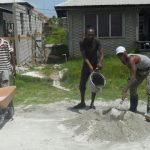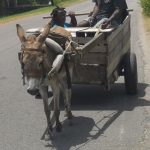Things were certainly looking up for me this week as I was heading to Stewartville, West Coast Demerara which I was told has a certain pristine beauty to its somewhat still ‘yesteryear appearance.’ On arriving there I felt quite at home since in some ways this village reminded me of my hometown, Calcutta, on the East Coast of Demerara.
Stewartville is a village in Guyana on the Atlantic Coast along West Demerara. There are four sections in the village: Stewartville Housing Scheme, Sarah Lodge, Stewartville Old Road and Stewartville Sea View.
Stewartville is about 10 miles (16 km) west of Vreed-en-Hoop, and is separated on the east from the neighbouring community of Leonora by a trench. The community of Uitvlugt is immediately to its west. The village is populated by various ethnic groups, and the fusion to me seems quite attractive. With the abolition of slavery throughout the British Empire in 1834, freed men began making group and individual purchase of land in the village. By the 1860s many Africans had settled in the Creole village of Stewartville and were working on the West Coast Demerara estates. There is a record of four Sierre Leonians in 1874 petitioning from Stewartville for a grant of crown land to cultivate rice on Hog Island, Essequibo.
Later, estate workers originally from South India came to the coast and introduced their own traditions. The Indians mostly settled in areas between the Afro-Guyanese villages. A mosque was built in Stewartville around 1911. As of 2011 the village had a population of about 2,500 which has however increased significantly over the years.
Climate
Temperature is fairly steady throughout the year at between 25 °C (77 °F) and 27 °C (81 °F). There are two wet seasons in May–July and in December–January. Average monthly rainfall ranges from 104 millimetres (4.1 in) in September to 383 millimetres (15.1 in) in June, with about 2,670 millimetres (105 in) annually. Stewartville has a secondary school, serving other communities in the region.
Interacting with residents
Quite honestly many persons were a bit bashful about speaking to the media and the few that did, chatted with some amount of reluctance.
However a vendor Sybil Bacchus engaged me in conversation and divulged that while things are gradually looking up in the village, everything is not however perfect. She spoke about erosion of their shore which she said has been a continuous problem.
. Excessively high tides on October16–17, 2005 caused breaches of the sea defences on West Coast Demerara. In November the government announced it had approved contracts for emergency repairs. $102M was to be spent on obtaining and laying boulders along the sea defence line at Stewartville and Leonora. The work was being funded from a 38.9 Euro grant agreement under the Eighth European Development Fund. In December 2009 a high spring tide caused waves that over-topped the seawall and flooded many yards in Sea View.
In October 2010 the contractor working on a project to repair the sea defences recommended using riprap construction as an alternative to building wave walls. With riprap construction, loose boulders absorb the force of the waves. Unlike wave walls, which tend to be undermined, crack and require expensive repair, riprap defences need little maintenance.
Simple means of survival
Some villages really stand out and rank high on the charts for simple means of survival, and Stewartville is no exception.
And this fact was dictated by the individuals with whom I interacted around the village. One very kind woman (Katherine Semple) offered me a seat under her makeshift vegetable stand to escape the downpours and our conversation revealed quite a lot about her simple existence.
This very elderly woman who seemed very peppy at age sixty -nine explained that selling vegetables and ground provision by the roadside has been an occupation she has been indulged in for over ten years. She explained that her ailing husband ‘Ronald’ was never able to do strenuous jobs because of an ailment and as such she was forced to find something to do to help out in the home.
“I am a poor woman and my husband was always sick most of the time. So I had to find a way to help feed and clothed the six children we made together. I does mek a lil good raise most times, but sometimes sales can be real bad and very slow. On those days I will pick meh eddo leaf from the back yard and mek stew fuh de children and we use to enjoy it, ‘ital style.”
A seemingly contented soul, Katherine still comes out on the road early to sell, although her two daughters insist that she quits the profession altogether. “My daughters do not want me to sell here…. They want to take care of me themselves, but they are married now and have their own lives and family to tend to. So while I will accept the little they give me, I still want to sell to earn something for myself. Besides I am still fit for my age, so it’s really not a problem…..”
Stewartville in times gone by
It was Katherine too who was willing to tell me a little about Stewartville as it appeared in the olden days.
Living in the village almost from her early childhood she explained that in her time the village was a very underdeveloped settlement where residents would go to great lengths to ensure they existed in comfort.
According to the good lady, some areas of the village was very bushy and transportation in those days were the horse drawn and donkey carts, which were later replaced (not completely) by bicycles and later vehicles as the petals of modernisation unfurled. In her time young girls played ‘hop scotch’ in the dusty streets and dams while energetic males would engage in feisty games of marble, cricket and football, which in many times ended in verbal disagreements and even fist fights.
Many used water from flowing ponds and trenches, until the era of stand pipes and artesian wells arrived. The houses were mostly cottage style, many of them with shingle roofs, while a few were even covered with coconut branches.
She reminisced on having little picnics and ‘bush cooks’ with her girlfriends in their back yard or open fields after which they would play circle tennis until their mothers bellowing would bring them scattering home from wherever they were. There were really no fancy shops or boutiques there, and in Katherine’s time the little girls were mostly clothed in home sewn dresses that lacked a proper finish. While today Stewartville has evolved considerably, the village however somehow still hold signs of its somewhat yesteryear appearance.
Drainage seems to be a major problem in this village. Most of the trenches are overgrown with weeds, bushes and various plant parasites.
There is just not much scope for employment in this village and the few occupants are not too interested in having kitchen gardens as is the case in the surrounding villages. Some residents are either pork-knockers in the interior, or sell in shops, food stalls or other businesses that have sprung up in the village. Others are content to have obtained job as teachers at schools in and around the village, while other travel miles away to work with various entities as labourers.
One woman noted that regular employment abounds periodically during the rice harvesting seasons, when rice farmers in areas outside the village will require plenty of manual labour for harvesting, paddy drying and milling.
Speaking for a group of young men liming in the streets, 19 year-old Shawn Williams noted that there is not much scope for academically qualified youths in the village. He said several individuals would normally excel at the CSEC examinations but remain in the village unemployed or is forced to engage in professions that do not give credit to their credentials.
Self Help Indulgence
What struck me and was very pleasing to the eyes is the manner in which villagers exuded a ‘ready to go attitude’ and seemed ready to ‘fix things’ in the village and not wait on the relative authorities who sometimes seems to drag their feet on issues.
As we walked about the village, young men could be seen weeding drains, and yards overgrown with bushes, whiles others were observed mixing cement by the roadside to make repairs, and alterations to their homes.
We were very surprised when we were told that some of the more magnificent buildings in the housing scheme were actually built through combined family efforts. Sure it seemed villagers are actually gifted tradesmen.
Ethnic fusion
Some residents reported that many years ago there were serious ethnic classes in the village, and while that may have been so, things seemed to have changed for the good. And this could be affirmed from the jovial and pleasant interaction amongst residents of varying races in the streets, over fences and of course in the shops in the village.
Young men of varying races were seen at intervals chatting quite amicably at the street corners, and ever so often their loud masculine guffaws and boisterous laughter will ring out as jokes are told and many engaged in their popular ‘tantalise sessions.’
Amusing reflections
Every village certainly possesses a certain little juicy gossip that would cause you to buckle over with laughter and Stewartville was no exception.
One very sassy lady seemed to be the gossip icon in the village and upon gleefully enquiring she said: “Dis village full a tek ups like anywhere else….. Ah gon tell yuh a story but me ain’t want me name call…”
She related amidst peals of laughter that in October 2010 a boat carrying drinks and other products from the Banks DIH company to the Essequibo Coast developed leaks and had to be grounded on the Stewartville foreshore. Mud had apparently got into the pump, which would not start, and the engine room flooded. After the tide receded, the boat leaned to one side. Some boxes fell off and were reportedly taken away by residents. Giggling hysterically the woman said that night, dozens of people climbed onto the boat, taking soft drinks and alcoholic drinks, as well as other products such as biscuits and bottled water, and drained the fuel from the boat’s tanks. She said some started drinking while they were looting. One man, it was reported apparently became drunk, and fell into the water and drowned between the boat and the sea wall.
She seemed to have every bit of information on the happenings in the village; because she let on that in March 2011 a fire broke out in the village. A fire tender was quickly dispatched from Leonora Fire Station, and used the water in the tender to stop the fire from spreading. When the fire-fighters attempted to get more water from the nearby canal, it turned out to be full of silt and debris, which damaged the pump. Again my informant divulged that the Neighbourhood Democratic Council (NDC) had been failing to maintain the canals during that period.
Notable people
Allan Carlyle Miller was born in Stewartville Village on September 19, 1898. After training in the southern United States as a doctor and a Baptist minister, he returned to Guyana and established the Guyana Missionary Baptist Church Lott-Carey. The well-known artist Donald Locke was born there in 1930. Locke started to study painting under E. R. Burrowes in the Working People’s Art Class in Georgetown in 1947. In 1979 he moved to the United States, dying in Atlanta Georgia in December 2010. In 1973, Stewartville was home to Diana Amelia Barrow, who was 107 years old. She was the mother of six children, two of whom had died, and had 23 grandchildren.
Retired Justice Oslen Small and former Chancellor of the Judicial Keith Massiah were also prominent personalities who hailed from Stewartville.
Sad tidings
Villagers still reflect and talk about the ghastly incident that occurred in the village not so long ago that involved a farmer Jamaludin Sattaur, 56, who was also an ex-soldier, and was found murdered in his Stewartville home. They said his home was invaded by bandits twice.
According to reports, his reputed wife, Genevieve Hartman, 62, a security guard then attached to the Ministry of Agriculture at Den Amstel, had left home about 06:30 hours for work leaving her husband home alone.
She returned home at 07:00 hours on the following morning and opened the front door to the building via the lower flat and found her husband’s lifeless body near the stairway by the kitchen. Villagers said the man’s face was covered and head was bashed in. The wife had run out of the house screaming and alerted the neighbours.
Some said that the entire house from the lower flat to the upper flat was ransacked, suggesting that the perpetrators had spent a lot of time inside the building.
It is believed that the intruders gained entry to the upper flat of the house by using a wooden bench to scale the window on the eastern side and then they entered the upper flat of the house and burglarised the place of valuables.
By Alex Wayne




.png)



















